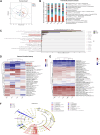Decoction derived from Allium ascalonicum L. bulbs and Sojae Semen Praeparatum alleviates wind-cold-type common cold via Nrf2/HO-1 pathway and modulation of Lactobacillus murinus level
- PMID: 38803435
- PMCID: PMC11129017
- DOI: 10.3389/fphar.2024.1364328
Decoction derived from Allium ascalonicum L. bulbs and Sojae Semen Praeparatum alleviates wind-cold-type common cold via Nrf2/HO-1 pathway and modulation of Lactobacillus murinus level
Abstract
Background: Cong-Chi decoction (CCD) is made using Allium ascalonicum L. (shallot) bulbs and Sojae Semen Praeparatum (SSP). Shallot bulbs and SSP are both used regularly in traditional Chinese medicine; however, there are no recent pharmacological studies on their synergistic effects. Despite their roles in the treatment of the common cold for thousands of years, their pharmacological mechanisms of action against wind-cold-type common cold are yet to be explored comprehensively.
Methods: A mouse model was standardized using wind-cold modeling equipment to study the anti-inflammatory, antioxidant, and antiapoptotic effects of CCD. Then, 16S rRNA sequencing was employed to analyze the association between Lactobacillus murinus and changes in body temperature. Additionally, the antipyretic effects of L. murinus were validated via animal experiments.
Results: The results indicate that CCD improves the symptoms of wind-cold by reducing fever, levels of pro-inflammatory factors, and cellular apoptosis, as well as increasing the blood leukocyte and lymphocyte counts, thereby alleviating lung tissue damage. The effects of CCD are mediated by upregulation of pulmonary Nrf2 and HO-1 expressions, thereby reducing oxidative damage in the lungs, in addition to other anti-inflammatory mechanisms. Furthermore, CCD increases the abundance of L. murinus in the intestinal tract. The animal experiments confirm that L. murinus ameliorates fever in mice.
Conclusion: CCD exhibits remarkable antioxidant and anti-inflammatory properties for effectively treating wind-cold-type common cold. Furthermore, its regulatory effects on L. murinus represent a novel mechanism for product development.
Keywords: Allium ascalonicum L. bulbs; Lactobacillus murinus; Glycine max (L.) Merr; Nrf2/HO-1 pathway; Sojae Semen Praeparatum; wind-cold-type common cold.
Copyright © 2024 Jiang, Wei, Zhou, Qiu, Yang, Huo and Wang.
Conflict of interest statement
The authors declare that the research was conducted in the absence of any commercial or financial relationships that could be construed as a potential conflict of interest.
Figures









Similar articles
-
Semen Sojae Praeparatum alters depression-like behaviors in chronic unpredictable mild stress rats via intestinal microbiota.Food Res Int. 2021 Dec;150(Pt B):110808. doi: 10.1016/j.foodres.2021.110808. Epub 2021 Nov 9. Food Res Int. 2021. PMID: 34863499
-
Muscone Ameliorates High-Altitude Hypoxia Gastrointestinal Stress via Modulation of Lactobacillus Murinus and Mitochondrial Metabolism.J Inflamm Res. 2025 May 26;18:6683-6701. doi: 10.2147/JIR.S521991. eCollection 2025. J Inflamm Res. 2025. PMID: 40453964 Free PMC article.
-
Investigation of the potential curative effects of Gui-Zhi-Jia-Ge-Gen decoction on wind-cold type of common cold using multidimensional analysis.J Ethnopharmacol. 2022 Nov 15;298:115662. doi: 10.1016/j.jep.2022.115662. Epub 2022 Aug 27. J Ethnopharmacol. 2022. PMID: 36031102
-
Therapeutic Uses and Pharmacological Properties of Shallot (Allium ascalonicum): A Systematic Review.Front Nutr. 2022 Jul 28;9:903686. doi: 10.3389/fnut.2022.903686. eCollection 2022. Front Nutr. 2022. PMID: 35983491 Free PMC article. Review.
-
[History of processing of Sojae Semen Praeparatum].Zhongguo Zhong Yao Za Zhi. 2018 May;43(10):1985-1989. doi: 10.19540/j.cnki.cjcmm.20180117.008. Zhongguo Zhong Yao Za Zhi. 2018. PMID: 29933660 Review. Chinese.
Cited by
-
Recent Research Advances in Multi-Functional Diallyl Trisulfide (DATS): A Comprehensive Review of Characteristics, Metabolism, Pharmacodynamics, Applications, and Drug Delivery Systems.Int J Nanomedicine. 2025 Apr 9;20:4381-4398. doi: 10.2147/IJN.S511417. eCollection 2025. Int J Nanomedicine. 2025. PMID: 40225218 Free PMC article. Review.
References
-
- Adeyemo A. E., Omoba O. S., Olagunju A. I., Josiah S. S. (2023). Assessment of nutritional values, phytochemical content, and antioxidant properties of Shallot (Allium ascalonicum L.) leaf and bulb. Meas. Food. 10, 100091. 10.1016/j.meafoo.2023.100091 - DOI
LinkOut - more resources
Full Text Sources

